Rear admiral
Rear admiral is a senior naval flag officer rank, equivalent to a major general and air vice marshal and above that of a commodore and captain, but below that of a vice admiral. It is regarded as a two star "admiral" rank. In many navies it is referred to as (OF-8)/(O-8).
| Naval officer ranks |
|---|
| Flag officers |
| Senior officers |
| Junior officers |
It originated from the days of naval sailing squadrons and can trace its origins to the Royal Navy. Each naval squadron would be assigned an admiral as its head, who would command from the centre vessel and direct the activities of the squadron. The admiral would in turn be assisted by a vice admiral, who commanded the lead ships which would bear the brunt of a naval battle. In the rear of the naval squadron, a third admiral would command the remaining ships and, as this section of the squadron was considered to be in the least danger, the admiral in command of the rear would typically be the most junior of the squadron admirals. This has survived into the modern age, with the rank of rear admiral the most-junior of the admiralty ranks of many navies.
In some European navies (e.g., that of France), and in the Canadian Forces' French rank translations, the rank of rear admiral is known as contre-amiral. In the German Navy the rank is known as Konteradmiral, superior to the flotilla admiral (Commodore in other navies). In the Royal Netherlands Navy, this rank is known as schout-bij-nacht (lit.: supervisor during night), denoting the role junior to the squadron admiral, and fleet admiral.
Australia
| Rear admiral (Australia) | |
|---|---|
 The RADM insignia | |
_OF-7.svg.png) | |
| Country | |
| Service branch | |
| Abbreviation | RADM |
| Rank | Two-star |
| NATO rank | O-9 |
| Next higher rank | Vice admiral |
| Next lower rank | Commodore |
| Equivalent ranks | |
The Royal Australian Navy maintains a rank of rear admiral; refer to Australian Defence Force ranks and insignia. The abbreviation is RADM.
Since the mid-1990s, the insignia of a Royal Australian Navy rear admiral is the Crown of St. Edward above a crossed sword and baton, above two silver stars, above the word "Australia". Like the Royal Navy version, the sword is a traditional naval cutlass. The stars have eight points, unlike the four pointed Order of the Bath stars used by the army (which are often referred to as "pips"). Prior to 1995, the RAN shoulder board was identical to the Royal Navy shoulder board. The Royal Navy shoulder board changed again in 2001 and the Australian and UK shoulder boards are now identical except for the word "Australia".[1]
Rear Admiral Robyn Walker AM, RAN became the first female admiral in the Royal Australian Navy when she was appointed Surgeon-General of the Australian Defence Force on 16 December 2011.[2]
Canada
In the Royal Canadian Navy, the rank of rear-admiral (RAdm) (contre-amiral or CAm in French) is the Navy rank equivalent to major-general of the Army and Air Force. A rear-admiral is a flag officer, the naval equivalent of a general officer. A rear-admiral is senior to a commodore and brigadier-general, and junior to a vice-admiral and lieutenant-general.
The rank insignia for a rear-admiral is two silver maple leaves beneath a silver crossed sword and baton, all surmounted by St Edward's Crown, worn on gold shoulder boards on the white short-sleeved shirt or the tropical white tunic. The service dress features a wide strip of gold braid around the cuff and, since June 2010,[3] above it a narrower strip of gold braid embellished with the executive curl. On the visor of the service cap are two rows of gold oak leaves.
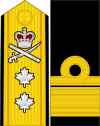
Canadian rear admiral shoulder board and sleeve insignia (since June 2010). 
Uniform shirts 
CADPAT uniform
Germany
Konteradmiral is an OF-7 two-star rank equivalent to the Generalmajor (en: Major general) in the German Army and the German Air Force.
Guyana
The Guyana Defence Force Coast Guard is the naval component of the Military of Guyana. As such, the ranks of the Coast Guard are naval ranks similar to the practice in the respective Coast Guards of Jamaica and Trinidad and Tobago. The rank of rear admiral was first awarded to chief of staff commodore Gary Best on August 19, 2013.
The rank insignia consists of two silver pips with green highlights, beneath a crossed sword and baton (also silver colored), all surmounted by the gold-colored Cacique's crown with red, and green highlights.

GDF Coast Guard rear admiral shoulder board
India
The Indian Navy also maintains a rear admiral rank senior to commodore and captain ranks and junior to vice admiral (and admiral) ranks.
_OF-7.svg.png)
Indian Rear Admiral sleeve insignia 
Shoulder board for Rear Admiral
The rank insignia for a rear-admiral is two stars beneath crossed sword and baton, all surmounted by Emblem of India, worn on shoulder boards.
Iran
Before Islamic Revolution (1979)
The Iranian Imperial Navy (IIN).
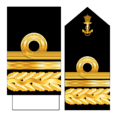 Daryaban (دریابان)
Daryaban (دریابان)
After Islamic Revolution (1979)
The Islamic Republic of Iran Navy (IRIN), also known as the Iranian Navy.
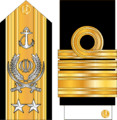 Daryaban (دریابان)
Daryaban (دریابان)
Pakistan
A rear admiral in the Pakistani Navy is a senior and two-star rank naval officer, appointed in higher naval commands. Like most Commonwealth navies, the rear admiral rank is superior to commodore and captain. However, the rank is junior to the three-star rank vice-admiral and four-star rank admiral, who is generally a Chief of Naval Staff of the Navy.
Namibia
 Rear Admiral Shoulder board
Rear Admiral Shoulder board
The rank of Rear Admiral is normally held by the Commander of the Namibian Navy.
Netherlands
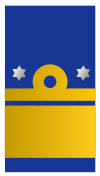
Schout-bij-nacht (pronounced [ˈsxʌu̯d bɛi̯ ˈnɑxt])[4] is a Dutch Naval rank, equivalent to rear admiral in the US Navy and Royal Navy. It is the second most junior admiral position of the Dutch Navy, ranking above commandeur ("commodore") and below a vice-admiraal ("vice admiral").
The rank of schout-bij-nacht originated between the 15th and 16th century. Interpreted as "watch-at-night", the schout-bij-nacht was the officer who supervised the ship when the captain was asleep.
In later times the schout-bij-nacht was also the officer who supervised an entire naval squadron, in the absence of a senior admiral, and by the 17th century schout-bij-nacht was the common rank held by the naval commander of a battle fleet's rear squadron.
In the 17th century the navies of Sweden and Denmark-Norway adopted the rank as schoutbynacht and the early Imperial Russian Navy as шаутбенахт ("shautbenakht"). In 1724 the Russians, followed in 1771 by both the Swedish navy and the Dano-Norwegian navy changed the name of the rank to counter admiral (контр-адмирал in Russian, konteramiral in Swedish, kontreadmiral in Danish and Norwegian).
New Zealand
The highest ordinary rank currently filled in the Royal New Zealand Navy is rear admiral and this is the rank held by the Chief of Navy[5] unless that person is also Chief of Defence Force.
Singapore
The Republic of Singapore Navy uses two ranks with the title of rear admiral: rear-admiral (one-star), a one-star rank; and rear-admiral (two-star), a two-star rank. Usually held by the Chief of Navy or Fleet Commander, the rank is reserved for the highest-ranking flag officer of the navy.
United Kingdom
The Royal Navy maintains a rank of rear admiral. Note that the rank of rear admiral is quite different from the honorary office Rear-Admiral of the United Kingdom.
United States
In the United States since 1984, there have been two ranks with the title of rear admiral: rear admiral (lower half) (RDML), a one-star rank; and rear admiral (RADM), a two-star rank. Prior to that, a combination of ranks was used.
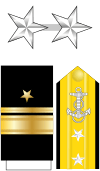 The stars and shoulder boards of a US Navy two-star, rear admiral
The stars and shoulder boards of a US Navy two-star, rear admiral The stars and shoulder boards of a US Coast Guard two-star, rear admiral
The stars and shoulder boards of a US Coast Guard two-star, rear admiral The star and shoulder boards of a US Public Health Service two-star, rear admiral
The star and shoulder boards of a US Public Health Service two-star, rear admiral The stars, shoulder boards, and sleeve stripes of a National Oceanic and Atmospheric Administration two-star, rear admiral
The stars, shoulder boards, and sleeve stripes of a National Oceanic and Atmospheric Administration two-star, rear admiral
Vietnam
In Vietnam, the equivalent to rear admiral is the Chuẩn Đô đốc or Đề Đốc which is a 1-star rank. It is below the vice admiral (2 star) and above senior captain (of the Navy).
See also
- Ranks and insignia of officers of NATO navies
References and notes
- "Uniform Ranks". Royal Australian Navy. Australian Government. Archived from the original on 24 January 2015. Retrieved 17 April 2016.
- "First female Admiral for the Royal Australian Navy". Defence News. Department of Defence, Australian Government. 6 December 2011.
- "Archived copy" (PDF). Archived from the original (PDF) on 9 June 2011. Retrieved 6 July 2010.CS1 maint: archived copy as title (link) The Maple Leaf/La Feuille d'érable – no. 13 vol.18
- Schout in isolation: [ˈsxʌu̯t].
- "Rear Admiral Jack Steer Appointed Chief of Navy". Royal New Zealand Navy. Royal New Zealand Navy. Retrieved 15 November 2014.